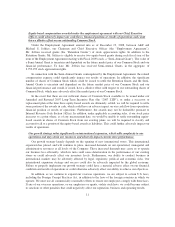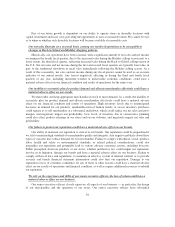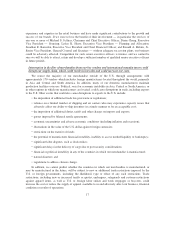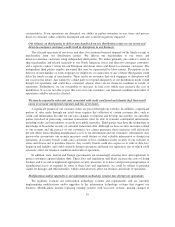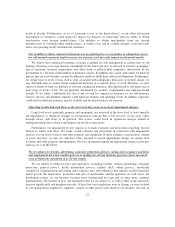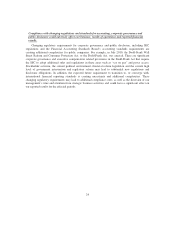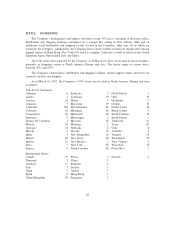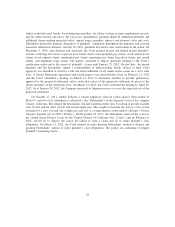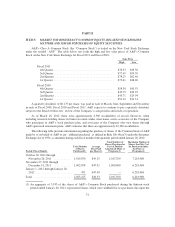Abercrombie & Fitch 2011 Annual Report Download - page 24
Download and view the complete annual report
Please find page 24 of the 2011 Abercrombie & Fitch annual report below. You can navigate through the pages in the report by either clicking on the pages listed below, or by using the keyword search tool below to find specific information within the annual report.
Because we have not yet registered all of our trademarks in all categories, or in all foreign countries in
which we source or offer our merchandise now, or may in the future, our international expansion and our
merchandising of products using these marks could be limited. For example, we cannot ensure that others
will not try to block the manufacture, export or sale of our products as a violation of their trademarks or
other proprietary rights. The pending applications for international registration of various trademarks could
be challenged or rejected in those countries because third parties of whom we are not currently aware have
already registered similar marks in those countries. Accordingly, it may be possible, in those foreign
countries where the status of various applications is pending or unclear, for a third-party owner of the
national trademark registration for a similar mark to prohibit the manufacture, sale or exportation of
branded goods in or from that country. If we are unable to reach an arrangement with any such party, our
manufacturers may be unable to manufacture our products, and we may be unable to sell in those countries.
Our inability to register our trademarks or purchase or license the right to use our trademarks or logos in
these jurisdictions could limit our ability to obtain supplies from, or manufacture in, less costly markets or
penetrate new markets should our business plan include selling our merchandise in those non-U.S.
jurisdictions.
We have an anti-counterfeiting program, under the auspices of the Abercrombie & Fitch Brand
Protection Team, whose goal is to eliminate the supply of illegal pieces of our products. The Brand
Protection Team interacts with investigators, customs officials and law enforcement entities throughout the
world to combat the illegal use of our trademarks. Although brand security initiatives are in place, we
cannot guarantee that our efforts against the counterfeiting of our brands will be successful.
Fluctuations in our tax obligations and effective tax rate may result in volatility in our operating
results.
We are subject to income taxes in many U.S. and certain foreign jurisdictions. In addition, our
products are subject to import and excise duties and/or sales, consumption or value-added taxes (or
“VAT”) in many jurisdictions. We record tax expense based on our estimates of future payments, which
include reserves for estimates of probable settlements of foreign and domestic tax audits. At any one time,
many tax years are subject to audit by various taxing jurisdictions. The results of these audits and
negotiations with taxing authorities may affect the ultimate settlement of these issues. As a result, we
expect that throughout the year there could be ongoing variability in our quarterly tax rates as taxable
events occur and exposures are evaluated. In addition, our effective tax rate in any given financial
statement period may be materially impacted by changes in the mix and level of earnings or by changes to
existing accounting rules or regulations. Fluctuations in duties could also have a material impact on our
financial condition, results of operations or cash flows. In some international markets, we are required to
hold and submit VAT to the appropriate local tax authorities. Failure to correctly calculate or submit the
appropriate amounts could subject us to substantial fines and penalties that could have an adverse effect on
our financial condition, results of operations or cash flows. In addition, tax legislation may be enacted in
the future, domestically or abroad, that impacts our current or future tax structure and effective tax rate.
The effects of war or acts of terrorism could have a material adverse effect on our operating results
and financial condition.
The continued threat of terrorism and the associated heightened security measures and military actions
in response to acts of terrorism have disrupted commerce and have intensified uncertainties in the U.S.
economy. Any further acts of terrorism or a future war may disrupt commerce and undermine consumer
confidence, which could negatively impact our sales revenue by causing consumer spending and/or mall
21


